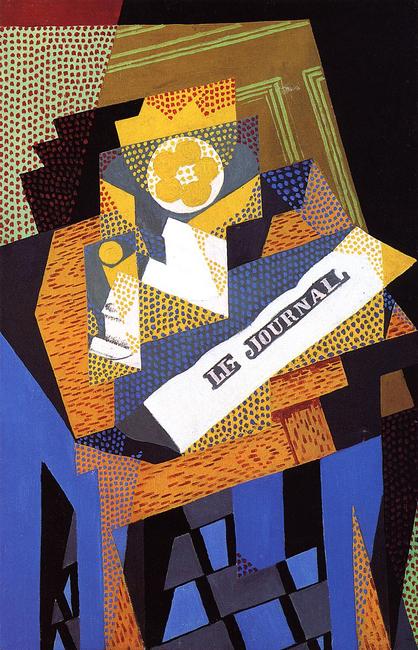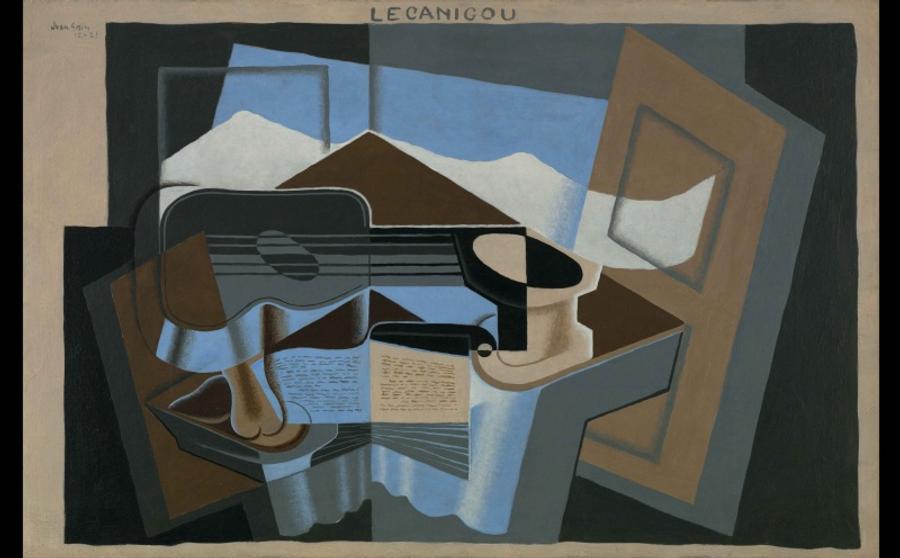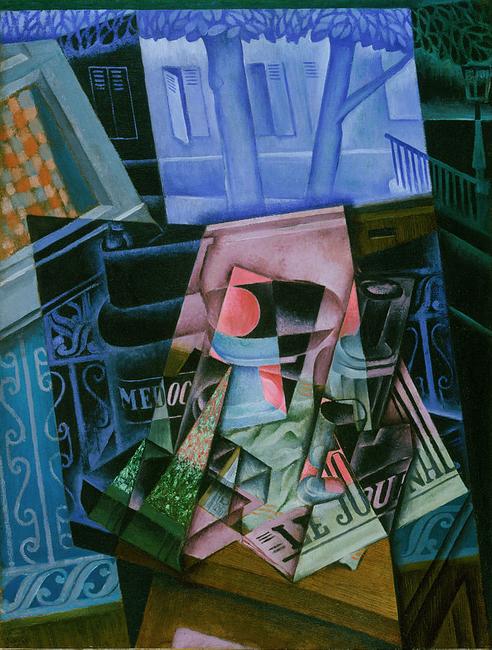Dallas Museum of Art
November 8, 2020, through February 14, 2021
Baltimore Museum of Art
March 21 through July 11, 2021
The Dallas Museum of Art (DMA) and The Baltimore Museum of Art (BMA) have announced the co-organization of the first U.S. exhibition in over 35 years dedicated to the Spanish artist Juan Gris. Cubism in Color: The Still Lifes of Juan Gris highlights the artist’s pioneering and revolutionary contributions to the Cubist movement by focusing on his fascination with subjects drawn from everyday life. Through more than 40 paintings and collages that span all major periods of the artist’s evolving practice, the exhibition reveals the transformation of Gris’s innovative style and principle motifs from 1912 until 1926, one year before his tragically early death at age 40.

His exquisite compositions explored the boundary between abstraction and representation, tension and stasis, color and form. As a thorough examination of Gris’s still lifes, Cubism in Color provides an opportunity to reconsider the legacy of this important yet underappreciated modernist master.
Cubism in Color: The Still Lifes of Juan Gris is co-curated by Nicole R. Myers, The Barbara Thomas Lemmon Senior Curator of European Art at the DMA, and Katy Rothkopf, the BMA’s Senior Curator and Department Head of European Painting and Sculpture. It will premiere in Dallas from November 8, 2020, through February 14, 2021, and then travel to Baltimore, where it will be presented from March 21 through July 11, 2021. The exhibition will include important loans from international collections including the Museum of Modern Art, New York; the Philadelphia Museum of Art; the National Gallery of Art, Washington, D.C.; and the Telefónica Cubist Collection and Museo Nacional Centro de Arte Reina Sofía in Madrid, Spain, among others.
“It is extraordinarily rare to see so many works by Juan Gris together, particularly in the United States. We are pleased to bring them together for this exhibition to offer a rich and nuanced re-examination of the artist’s important role in a defining art-historical movement,” said Dr. Agustín Arteaga, the DMA’s Eugene McDermott Director. “As the DMA aims to explore new or underrepresented narratives in art history through its exhibitions and programs, we’re excited to introduce our audiences to the life and legacy of this principal figure within Cubism.”

“Juan
Gris’s incredible use of and experimentation with color and form
reverberate across modern and contemporary art movements. The upcoming
exhibition offers a fresh opportunity to examine a daring and deeply
accomplished yet lesser-studied artist, providing new insights into the
development of Cubism and the evolving narrative of art more broadly. We
are delighted to collaborate with the DMA on the creation of this
exhibition, and we look forward to engaging our many audiences in the
brilliance of Gris’s practice,” said Christopher Bedford, the BMA’s
Dorothy Wagner Wallis Director.

Born José Victoriano Carmelo Carlos González-Pérez in Madrid, Juan
Gris (1887–1927) was one of the primary contributors to the development
of Cubism in the early 20th century. Though he was championed by art
dealers Daniel Kahnweiler and Léonce Rosenberg and writer and art
collector Gertrude Stein, who considered him “a perfect painter,” Gris’s
pivotal role within the movement has often been overshadowed by his
better-known cohorts Pablo Picasso, Georges Braque, and Fernand Léger.
His works are among the movement’s most distinctive and inventive,
building upon early Cubist precedents with experimental and exquisite
still-life compositions distinguished by their vibrant colors, bold
patterns, and a constantly shifting approach. By bringing together more
than 40 of Gris’s most distinctive still lifes from major European and
American collections, Cubism in Color will reveal the virtuosic
range of the artist’s short yet prolific career, illuminating his
boundary-pushing contributions to Cubism and his assumption of the role
of the movement’s leader in the aftermath of World War I.
Cubism in Color: The Still Lifes of Juan Gris begins with Gris’s early paintings, such as Still Life with Flowers, which exemplify Analytic Cubism with faceted shapes and simultaneous viewpoints yet are distinctive in their systematic geometry, crystalline structure, and bright monochromatic palettes. The exhibition then chronicles a series of subsequent stylistic changes in Gris’s practice, starting with his transition to Synthetic Cubism. From about 1913 to 1916, Gris boldly experimented with trompe-l’oeil, collage, and pointillist techniques in increasingly abstract and dynamic compositions characterized by complex geometric patterns and dazzling colors applied in daring and novel combinations, as seen in The Siphon; Guitar and Pipe; Still Life: The Table; Still Life before an Open Window, Place Ravignan; Fantômas; and Newspaper and Fruit Dish.
Cubism in Color: The Still Lifes of Juan Gris begins with Gris’s early paintings, such as Still Life with Flowers, which exemplify Analytic Cubism with faceted shapes and simultaneous viewpoints yet are distinctive in their systematic geometry, crystalline structure, and bright monochromatic palettes. The exhibition then chronicles a series of subsequent stylistic changes in Gris’s practice, starting with his transition to Synthetic Cubism. From about 1913 to 1916, Gris boldly experimented with trompe-l’oeil, collage, and pointillist techniques in increasingly abstract and dynamic compositions characterized by complex geometric patterns and dazzling colors applied in daring and novel combinations, as seen in The Siphon; Guitar and Pipe; Still Life: The Table; Still Life before an Open Window, Place Ravignan; Fantômas; and Newspaper and Fruit Dish.
Gris drastically reinvented his
style between 1917 and 1920, adopting a more somber palette, simplifying
both his motifs and the geometric structure of his compositions, and
seeking a greater fusion of subject and ground. This second phase of
Cubism, often called Crystal or Classical Cubism, is characterized by
its emphasis on the purity and stability of form and composition. Gris
was hailed as the leader of this movement, and his work in this period,
such as Still Life with Newspaper; The Sideboard; and Guitar and Fruit Dish on a Table ,
was crucial to the development of Purism by his friends and fellow
artists Amédée Ozenfant and Le Corbusier, in addition to reflecting the
general “return to order” among the avant-garde following World War I.
Gris’s late production from 1920 to
1927 demonstrates a renewed interest in rich, vibrant hues and the
still life set before an open window, an innovative motif he first
introduced to Cubism in 1915 and revisited in works such as Le Canigou; The Painter’s Window; and Mandolin and Fruit Dish .
Notable for their harmonious, lyrical quality, these final works embody
yet another revolutionary shift in Gris’s aesthetic and approach as he
increasingly relied on the geometric, abstract structure of his
compositions to determine the still-life components integrated
seamlessly within them. A perfect union of what Gris called “flat,
colored architecture,” these works are a lasting testament to his
constant reinvention of Cubism and the deceivingly simple concept of the
still life.
“Gris was a prodigious talent,
achieving an incredible body of work in the short period he was active
as an artist. Just two years after he started painting, he emerged as a
quintessential member of the Cubist group with a distinct style that is
remarkable for its extraordinary refinement and rich color,” said Myers.
“His great ability to grasp, adapt, and repeatedly transform the Cubist
aesthetic makes worthy a deeper consideration not only of his
production, but of the role he played in shaping modern art in the first
quarter of the 20th century.”
“This exhibition gives us the wonderful opportunity to highlight
major works by Gris in both the DMA’s and BMA’s collections, putting
them into a new context for the first time in decades,” said
Rothkopf. “Seeing how Gris took the same motifs of musical instruments,
playing cards, newspapers, bottles, glasses, and table tops and used
them in his still-life compositions in different and innovative ways
throughout his brief but productive career is extraordinary.”
Cubism in Color: The Still Lifes of Juan Gris will be accompanied by a fully illustrated scholarly catalogue co-published by the DMA and BMA. The publication will include essays on Gris’s artistic process and legacy by co-curators Nicole R. Myers and Katy Rothkopf; Anna Katherine Brodbeck, the DMA’s Hoffman Family Senior Curator of Contemporary Art; Paloma Esteban Leal, Senior Curator of Painting and Drawing, 1881–1939, at the Museo Nacional Centro de Arte Reina Sofía; and Harry Cooper, Senior Curator and Head of Modern Art at the National Gallery of Art, Washington, D.C.
Cubism in Color: The Still Lifes of Juan Gris will be accompanied by a fully illustrated scholarly catalogue co-published by the DMA and BMA. The publication will include essays on Gris’s artistic process and legacy by co-curators Nicole R. Myers and Katy Rothkopf; Anna Katherine Brodbeck, the DMA’s Hoffman Family Senior Curator of Contemporary Art; Paloma Esteban Leal, Senior Curator of Painting and Drawing, 1881–1939, at the Museo Nacional Centro de Arte Reina Sofía; and Harry Cooper, Senior Curator and Head of Modern Art at the National Gallery of Art, Washington, D.C.

Juan Gris, Guitar and Pipe, 1913, oil and charcoal on canvas, Dallas Museum of Art, The Eugene and Margaret McDermott Art Fund, Inc.;

Juan Gris, The Painter’s Window , 1925, oil on canvas, Baltimore Museum of Art: Bequest of Saidie A. May. Photography by Mitro Hood